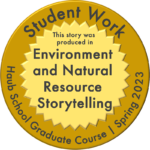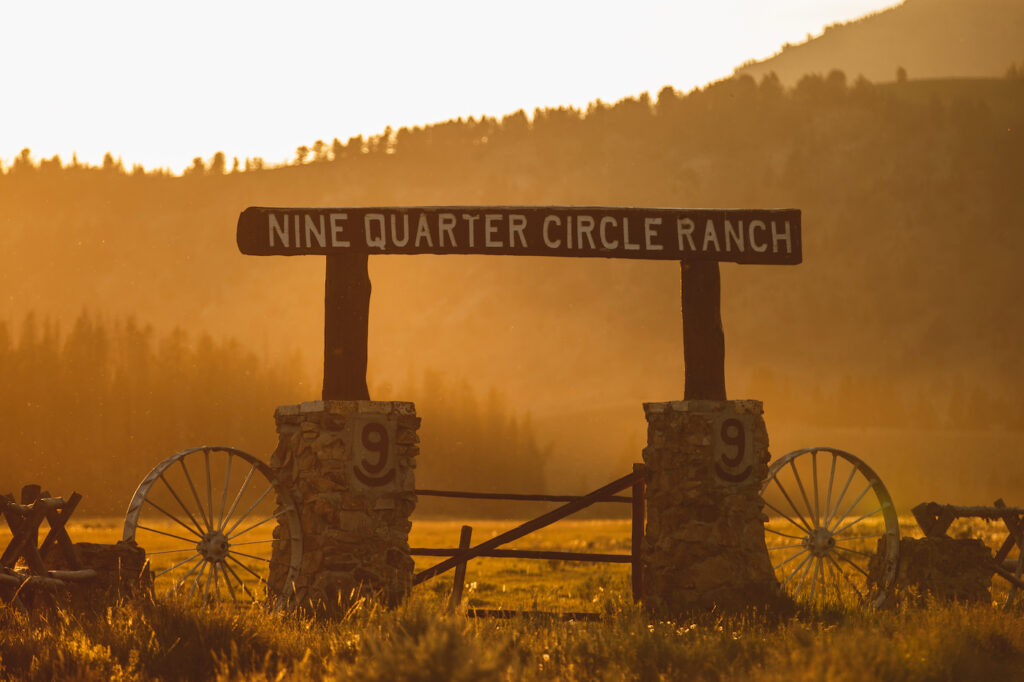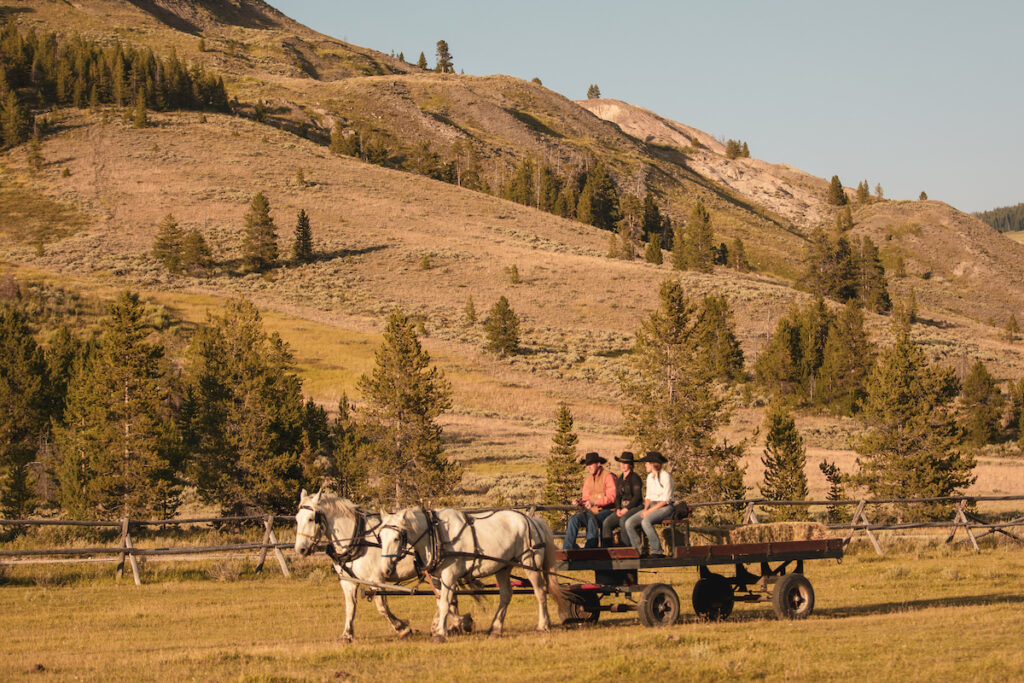Dude ranching offers a compelling model for sustainable tourism in the West
By Graham Marema
Just before sunrise, Nine Quarter Circle Ranch wakes up. The valley is still blue with fog, and wranglers don cowboy hats and vests, shimmying their feet into worn boots. Guests wake and yawn over a communal meal of eggs, sliced fruit, and mugs of steaming coffee. Soon, the Appaloosa horses will come thundering down from their night pastures into the corral, followed by the hooting wranglers, for a day of riding beneath the Taylor Peaks.
I could be describing a scene from 75 years ago, as this dude ranch began another day of horseback riding, fly fishing, and guiding guests over the scrubby hillsides of the Taylor Fork Valley. Or I could be describing a scene from this morning.
That’s sort of the point.
“Our motto is ‘time stands still,’” says Kameron Kelsey from beneath the rim of an old black cowboy hat. Kameron runs the Nine Quarter Circle Ranch in southern Montana, right outside Yellowstone National Park, along with his wife Sally. They host some 600 guests at their ranch each year. “I mean, we have a guest here this week who came in the early ’60s as a young child, and it hasn’t changed. That’s part of the appeal and charm of the place.”
That longevity is something other tourism sectors have, at times, struggled to replicate. For western outdoor tourism, the question of sustainability—which requires balancing the positive and negative impacts on local ecosystems, economies, and cultures—grows more crucial every year. As visitors arrive so do economic opportunities but often at a cost to local communities. With tourism booms come complications, from increased housing prices, to human waste in fragile backcountry ecosystems, and more.
While tourism draws like rock climbing and winter sports have struggled to mediate their impact on local systems, dude ranching, a quietly understated western tourism industry, has remained popular, unobtrusive, and relatively unchanged for nearly 150 years. The timeless charm of dude ranching might provide a compelling example of a long-term recreational sector rooted in sustaining a cultural and natural way of life.

A dude ranch, also called a guest ranch, is distinct from a working ranch, whose sole purpose and income comes from cattle ranching. The dude ranch, by contrast, receives at least part of its income from hosting guests for cowboy-themed vacations. When the practice began in the late nineteenth century, ranches hosted these guests for free. The very first “dudes,” as visitors were called, were mostly folks from East Coast cities enamored with the western lifestyle. They felt drawn to the romantic image of the cowboy, a figure somehow unchanged by the quickening urban sprawl of eastern cities.
It wasn’t long before ranches found that guests were eager enough to pay for the chance to play cowboy. From there, an industry was born. Dude ranches popped up from Montana to Arizona, California to Washington. The railroad brought more dudes out West than ever, slick-haired and shiny-shoed, yearning for a vacation far from the city bustle. In the 1920s and ’30s, as people were leaving the countryside for urban jobs in offices and factories, the wide plains of the West offered a reprieve—a grounded, traditional experience that urbanites craved. Dude ranches became more popular with each passing year.
The same allure that tempted guests out West in the twentieth century continues to enamor tourists of the twenty-first. Check out Gwyneth Paltrow’s Instagram, or Carey Underwood’s, and you might catch them sunburnt and beaming in front of a picturesque mountain backdrop at a favored luxury ranch getaway. These dude ranches promise a reconnection with nature and authentic western lifestyle, where values and landscape haven’t changed in over a hundred years. Tourists who have never touched a horse before can clamber into a saddle and even wrangle some cattle. Think Billy Crystal in City Slickers.
“It’s a different type of vacation,” says Bryce Albright, director of the Dude Ranchers’ Association, which provides membership to more than 90 dude ranches across the West. “They’re more of an authentic western experience, which you can’t get anywhere else. When people come out West, yes, you’ll see the cowboys, and you’ll see the rodeos, but until you get immersed in that kind of culture, you won’t really have respect for it.”

So what has made this model of tourism sustainable for local environments, economies, and cultures? While some forms of outdoor recreation balance negative and positive impacts on local systems by introducing something new—new management plans, new renewable energy technologies, new ideas—dude ranches contend with all three pillars of sustainability by embracing something old, traditional, and relatively unchanged.
In a way, environmental sustainability is inherent to dude ranching. Knowing that their customers expect beautiful, pristine landscapes year after year and decade after decade, ranchers have incentive to be responsible stewards of that land. As Sally Kelsey puts it, “If Kameron’s family had chosen not to maintain a dude ranch… this landscape would have looked very different.”
That isn’t to say dude ranches never embrace new technologies. Take the solar panels soaking up rays outside Goosewing Ranch in Jackson, Wyoming, or the hydroelectric generator at Diamond D Ranch in Stanley, Idaho. In fact, the Dude Ranchers’ Association requires some form of environmental footprint reduction as a prerequisite for becoming a member.
But Sally points out another, less measurable way that dude ranching fosters environmental sustainability. “Something that is undervalued when it comes to our impact on conservation,” she says, “is our guests get to take rides in the country and learn to value a place that’s very different from where they come from. That would benefit the community should we ever have a threat to the area and need people to speak up about why this kind of place is special.” This is the same tactic the National Park Service has been using for years to instill a sense of urgency for conservation in park visitors: to care about something enough to fight for its protection, you have to see it for yourself.
When it comes to the second pillar of sustainability—economics—the industry is often “overlooked,” according to Bryce. “It doesn’t get the recognition,” she says of dude ranching’s economic impact. “Tourism organizations frequently overlook dude ranches because they don’t think it’s very big, but if you look over the past couple of years, they were probably some of the most visited vacation destinations in the US.”
It’s true that compared to tourism that brings people to stay and spend money in mountain towns, dude ranching’s contribution to a shared local economy may be smaller. Guests at the Kelseys’ ranch might eat a meal or two in Bozeman or spend a weekend in Yellowstone, and locals may find seasonal work on the ranch as wranglers, cooks, or housekeepers. But the economic contribution outside of the ranch itself is relatively humble.
Still, dude ranching has had an important economic impact on the ranching industry. For some ranches, opening their doors to guests has provided an economically viable alternative or supplement to raising cattle. “Agritourism,” which invites guests to vacation on farms and ranches, has grown in popularity among both tourists and their hosts with revenue tripling in the US between 2002 and 2017.
To examine dude ranching’s impact on the third pillar—culture—take a look at the Dude Ranchers’ Association’s six Hs: Hospitality, Heritage, Honesty, Heart, Hats, and of course Horses.
“We’re holding onto our forefather’s ruggedness and way of life and hoping to share that with as many people as we can,” says Kameron, who himself, as the third Kelsey to run Nine Quarter Circle, is evidence of this. Preserving an “authentic” and old-fashioned culture is baked into the dude ranch aesthetic, and that means immediate impact on culture in towns like Bozeman seems somewhat negligible. Dude ranches play on a romantic, mythologized image of the West that has drawn visitors for more than a century, and while skeptics may raise their eyebrows at the perpetuation of that myth, the “authenticity” of dude ranches being run by real ranchers plays a large role in local communities embracing them.
Arizona acknowledged the importance of this cultural preservation when it designated dude ranches as key heritage sites in 2022, creating the Arizona Dude Ranch Heritage Trail. The trail acknowledges dude ranches’ historical and cultural significance and puts frameworks in place to preserve these sites for future generations.
What’s more, relative to forms of outdoor recreation that entail high-speed sports or loud motors on public lands, dude ranch guests spend most of their time on private land, partaking in low-impact activities like horseback riding or branding their initials into leather belts. They aren’t as likely to leave trash on public trails or overburden the infrastructure of small mountain towns to the extent of other industries that rely on those towns to house, feed, and sustain their guests.
Dude ranches like the Nine Quarter Circle Ranch bring tourists into this region—to gain an appreciation for the land, spend their money, and celebrate local cultural heritage—without a significant cost to local communities. That seems like a pretty balanced version of the sustainability math equation. In the evening, the eggshell sky over the Taylor Fork Valley softens, and the ranch winds down for the night. The Appaloosas return to their grazing pastures. Cowboy hats sleep on hooks by the front doors of the cabins. Guests settle into bed, listening to the shush of the dark river, sore and sunburnt and smiling. Imagine how this scene will look in the next 75 years. My guess and hope—pretty much exactly the same.
Graham Marema is pursuing her MFA in creative writing from the University of Wyoming, with a concurrent degree in environment and natural resources. She is a writer from East Tennessee who often writes about landscape, ghosts, and SPAM.



We spent many summers at THE RANCH… if our children had to choose between Christmas and the ranch .. it would be the ranch … bring the Nine QuarterCircle… was an essential part of our lives.. Bobbi Hawkins
FABULOUS ARTICLE….
Our family visited Nine Quarter Circle Ranch for twelve summers. It was always an amazing experience. Seeing Montana on rides twice a day was exhilarating. The challenges, learning and improving riding skills while immersed in the landscape was thrilling. Great food. We relished the simple pleasures of an evening softball game, a cook out and the Saturday night Square dance event .They even host an adults only “happy hour”. We made so many memories. This family
Owned ranch is everything authentic and your article summed up exactly why a trip like this is worth every penny.